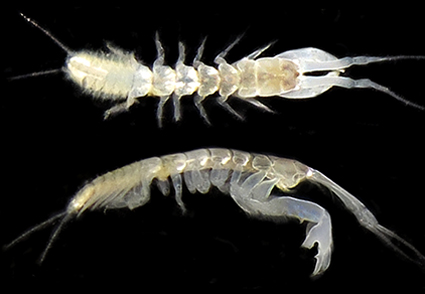Abstract
The article describes a new species of the genus Pseudohalmyrapseudes (Tanaidacea: Parapseudidae: Parapseudinae) found in the cut part of the deep channel of the Cần Giờ Mangrove Biosphere Reserve in South Vietnam. The new species shares morphological features of such parapseudid genera as Pseudohalmyrapseudes including a three- and four-articulated inner ramus of antennule in females and males, respectively, the triangular shape of fixed finger, and the presence of basal tooth on dactylus of cheliped in males. From Halmyrapseudes it is distinguished by the well-marked outer serration on the lobe of labium and the presence of relatively small blunt ventral tooth on carpus of the male cheliped. At the same time, it can be easily separated from any species of these genera by the shape of male cheliped, especially by the triangular shape of fixed finger and the presence of basal process tooth on dactylus, and the absence of plumose ventral setae on merus, carpus and propodus of pereopod VI. The new species is also unusual within the genus Pseudohalmyrapseudes in terms of habitat, as it lives in mangrove swamps rather than freshwater environments, known for congeners, and its distribution area, representing the first species from the Asian region. Based on the calculated density (124±17 inds/m2) and the trophic niche determined by the analysis of stable isotopes δ13C/δ15N, the studied species is considered among important primary consumers (C1), most likely feeding on the leaves of the mangrove Rhizophora apiculata in the studied lagoon.
References
- Alvaro, M.C., Błażewicz-Paszkowycz, M., Davey, M. & Schiaparelli, S. (2011) Skin-digging tanaidaceans: the unusual parasitic behaviour of Exspina typica in Antarctic waters and worldwide deep basins. Antarctic Science, 23, 343–348. https://doi.org/10.1017/S0954102011000186
- Anderson, G. (2023) Tanaidacea—Recent Scholarship (2000−present). March, 2023. https://aquila.usm.edu/tanaids30/6 (accessed 20 February 2024)
- Balasubrahmanyan, K. (1962) Apseudidae (Isopoda—Crustacea) from the Vellar Estuary and inshore waters off Porto. In: Seshaiya, R.V. (Ed.), Proceedings First All-India Congress of Zoology, 1959. Zoological Society of India, Calcutta, pp. 279–285.
- Błażewicz-Paszkowycz, M. (2014) 5.19. Tanaidacea. In: De Broyer, C., Koubbi, P., Griffiths, H.J., Raymond, B., d’Udekem d’Acoz, C., Van de Putte, A.P., Danis, B., David, B., Grant, S., Gutt, J., Held, C., Hosie, G., Huettmann, F., Post, A. & Ropert-Coudert, Y. (Eds.), Biogeographic atlas of the Southern Ocean. Scientific Committee on Antarctic Research. Cambridge, pp. 173–180.
- Błażewicz-Paszkowycz, M., Bamber, R. & Anderson, G. (2012) Diversity of Tanaidacea (Crustacea: Peracarida) in the World’s Oceans—How Far Have We Come? PLoS ONE, 7, 1–11. https://doi.org/10.1371/journal.pone.0033068
- Chapman, M.A., Lewis, M.H. & Winterbourn, M.J. (2011) Guide to the freshwater Crustacea of New Zealand. New Zealand Freshwater Sciences Society, Christchurch, 188 pp.
- Gardiner, L.F. (1975) A fresh- and brackish-water tanaidacean, Tanais stanfordi Richardson, 1901, from a hypersaline lake in the Galapagos Archipelago, with a report on West Indian specimens. Crustaceana, 29, 127–140. https://doi.org/10.1163/156854075X00144
- Guţu, M. & Iliffe, T.M. (2011) Leptochelia vatulelensis (Crustacea: Tanaidacea), a new species from anchialine caves of the south-western Pacific. Travaux du Museum National d’Histoire Naturelle Grigore Antipa, 54, 351–363.
- Hossain, M.D. & Nuruddin, A.A. (2016) Soil and Mangrove: A Review. Journal of Environmental Science and Technology, 9, 198–207. https://doi.org/10.3923/jest.2016.198.207
- Kakui, K., Kajihara, H. & Mawatari, S.F. (2010) A new species of Nesotanais Shiino, 1968 (Crustacea, Tanaidacea) from Japan, with a key to species and a note on male chelipeds. Zookeys, 33, 1–17. https://doi.org/10.3897/zookeys.33.296
- Kolevatov, V. & Marin, I. (2022) Mud shrimps of the genus Wolffogebia Sakai, 1982 (Decapoda: Gebiidea: Upogebiidae) with the description of a new species from the Cần Giớ Mangrove. Zootaxa, 5195 (1), 51–72. https://doi.org/10.11646/zootaxa.5195.1.3
- Larsen, K. & Hansknecht, T. (2004) A new genus and species of freshwater tanaidacean, Pseudohalmyrapseudes aquadulcis (Apseudomorpha: Parapseudidae), from Northern Territory, Australia. Journal of Crustacean Biology, 24 (4), 567–575. https://doi.org/10.1651/C-2494
- Marin, I.N. (2021a) A new species of the genus Potamalpheops (Crustacea: Decapoda: Alpheidae) from the intertidal mangrove swamps of South Vietnam. Arthropoda Selecta, 30 (2), 179–191. https://doi.org/10.15298/arthsel.30.2.05
- Marin, I. (2021b) A new infaunal species of the alpheid shrimp genus Salmoneus Holthuis, 1955 (Crustacea: Decapoda: Alpheidae) and a new crustacean association from anoxic mangrove habitats in southern Vietnam. Arthropoda Selecta, 30 (3), 369–385. https://doi.org/10.15298/arthsel.30.3.10
- Marin, I. & Palatov, D. (2022) Two new species of the genus Victoriopisa Karaman & Barnard, 1979 (Crustacea: Amphipoda: Eriopisidae) from mangrove communities of Vietnam with a review of previous records. Zootaxa, 5094 (1), 129–152. https://doi.org/10.11646/zootaxa.5094.1.5
- Marin, I., Palatov, D. & Nguyễn, V.T. (2024) A new species of the genus Ctenapseudes Bamber, Ariyananda & Silva, 1997 (Tanaidacea: Parapseudidae) from the Cần Giờ mangrove area in South Vietnam. Arthropoda Selecta, 33(2). [in press]
- Morales-Núñez, A.G. & Ramos-Tafur, G.R. (2023) Nototanoides oliveri, a new sponge-dwelling nototanaid tanaidacean (Crustacea, Tanaidomorpha, Tanaidacea) from eastern Gulf of Mexico, with an illustrated taxonomic key, and the first record of harpacticoid copepods within the marsupium of ovigerous female tanaids. Zootaxa, 5346 (3), 242–270. https://doi.org/10.11646/zootaxa.5346.3.2
- Ng, P.K.L. & Sivasothi, N. (2002) A guide to the mangroves of Singapore 1: The ecosystem and plant diversity. Singapore Science Centre, Singapore, 160 pp.
- Schram, F.R. (1986) Tanaidacea. In: Schram, F.R. (Ed.), Crustacea. Oxford, University Press, New York, New York, pp. 1–606.
- Shiino, S.M. (1965) Tanaidacea from the Bismark archipelago. Videnskabelige Meddelelser fra Dansk Naturhistorisk Forening i Kjøbenhavn, 128, 177–203.
- Suárez-Morales, E., Londoño-Mesa, M. & Heard, R.W. (2011) Discovery of a new genus of tanaidacean (Crustacea: Tanaidacea: Mirandotanaidae) found associated with a deep-sea terebellid polychaete. Contribution to Zoology, 80, 157–167. https://doi.org/10.1163/18759866-08002005


